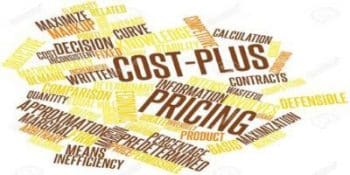If you buy a pack of salt from a grocery store or a luxury handbag, the price is often much higher than the cost of production. In certain situations, this sale price was calculated using a cost-plus pricing strategy, which involves adding a percentage to the product’s manufacturing cost. So, what exactly is cost-plus pricing and how does it work in a business? Read on to learn more about cost-plus pricing strategies, the formula, and some examples.
What is Cost-Plus Pricing?
Markup pricing is another term for cost-plus pricing. It is a pricing system in which a fixed percentage is applied to the cost of producing one unit of a product (unit cost); the resulting sum is the product’s selling price.
This pricing approach is based solely on unit costs and ignores competitor costs. As a result, it is often not the right fit for many companies because it does not account for external factors such as competitors.
Cost-Plus Pricing Strategy
A cost-plus pricing strategy, also known as a markup pricing strategy, is a straightforward pricing approach in which a fixed percentage is applied to the manufacturing cost for one unit of product (unit cost). This pricing policy disregards market demand as well as competitor costs.
Retailers frequently use it to price their items. Retailers also use cost-plus pricing (e.g., clothing, grocery, and department stores). In these cases, the products being sold vary, and different markup percentages may be applied to each commodity.
This pricing strategy isn’t appropriate if you sell software as a service (SaaS), since the value the goods offer is frequently greater than the costs to manufacture the products.
For companies who choose to follow a cost-leadership approach, the cost-plus pricing method is a good fit. By sharing their pricing policies with buyers and saying something like, “We’ll never charge more than X percent for our goods,” they can use cost-plus pricing as part of their value proposition.
This transparency helps create trust with potential customers and encourages companies to build a trustworthy brand.
How to Calculate Cost-Plus Pricing in 3 Easy Steps
Calculating cost-plus pricing for a commodity involves three steps:
- Step 1: Calculate the overall cost of the product or service. This is the amount of fixed and variable costs (fixed costs do not vary by the number of units, while variable costs do).
- Step 2: To calculate the unit cost, divide the total cost by the number of units.
- Step 3: To calculate the product’s selling price and profit margin, multiply the unit cost by the markup percentage.
Cost-Plus Pricing Formula
The cost-plus price is determined as follows with the formula when the profit margin is dependent on cost:
Price = Cost × (1 + Profit Margin Percentage)
When the profit margin is dependent on the sale price, the price is determined as follows:
Price = Cost/(1 – Profit Margin Percentage)
Where the profit is a fixed amount per unit:
Price = Cost + Profit
Examples of Cost-Plus Pricing
Let’s look at these examples using the formula to calculate cost-plus pricing.
#1. Cost-plus Pricing Example
You’re a cost accountant at GP Engineers & Contractors (GP), which recently secured a 10-year government contract to supply electricity to the country’s largest airport during power outages. GP is expected to set up a small diesel-powered power plant and operate and maintain it during the contract period. The contract states that GP will be reimbursed every month for the cost incurred per unit (kilowatt-hour) of electricity consumed from the GP system, plus a 20% profit on cost.
GP supplied the airport with 98,000 units from its power plant during the first month. During the month, the plant used 30,000 liters of diesel at a cost of $1 per liter. Employees who work at the power plant are paid $30,000 a month. The power plant’s head office costs for the month on account of management fees total $20,000. For the 10-year contract term, the plant is depreciated at a rate of $15,000 per month on a straight-line basis.
You must measure the sum you would invoice the government for the first month.
Assume the airport’s management has changed and the new CFO has asked GP to measure profit at 20% of revenue. Can GP consider such an offer?
The Solution
The first month’s total cost is the amount of diesel, labor, and manufacturing overhead costs) (including depreciation).
The cost of diesel is $30,000 (at $1 per liter for 30,000 liters), the cost of direct labor is $30,000, the management fee is $20,000, and depreciation is $15,000. The total expense is $95,000.
The first month’s invoice totals $114,000 (=$95,000 (1 + 20% )).
GP should be happy to adopt the new proposal because calculating invoice value at 20% profit based on sales will result in an increase in invoice amount.
Invoice Value (at 20% based on Sales) = $95,000/(1 – 20% ) = $118,750
Profit will rise from $19,000 (=$114,000 – $95,000) to $23,750 (=$118,750 – $95,000).
#2. Cost-plus Pricing Examples
Assume you’ve started a retail clothing line and need to figure out how much your jeans will sell for. The following are the costs associated with producing one pair of jeans:
- Price of materials: $10
- $30 for labor
- Overhead expenses: $15
The total cost comes to $55.00. With a 50% markup, the formula would be as follows:
Price to sell = $55.00 (1 + 0.50).
$55.00 is the selling price (1.50)
$82.50 is the selling price.
This results in a sale price of $82.50 per pair of jeans.
The Benefits and Drawbacks of a Cost-Plus Pricing Strategy
If you’re thinking of using a cost-plus pricing approach, you should balance the benefits and drawbacks. Here are a few important points to consider.
The Benefits of a Cost-Plus Pricing Strategy
#1. It’s easy to use.
A cost-plus pricing approach does not necessitate rigorous testing. Simply calculate your manufacturing costs (such as labor, supplies, and overhead) and set a markup price.
#2. The cost is justifiable.
The cost-plus pricing approach makes it simple to explain to customers why prices are changing. If a business has to boost its product’s selling price due to increasing production costs, the rise can be justified.
#3. It offers a steady rate of return.
When estimated correctly, cost-plus pricing can result in the coverage of all costs. Because of the markup figure, you should expect a stable rate of return.
The Disadvantages of a Cost-Plus Pricing Strategy
#1. The cost might be set too high.
Since this pricing technique does not take competitor rates into account, there is a chance that the selling price is too high. If customers chose to do business with a rival offering cheaper rates, this could result in a loss of revenue.
#2. There is no assurance that all expenses will be covered.
Before pricing a product, sales volume is estimated, and this projection is often unreliable. If sales are overestimated and a low markup is used to price the product, fewer products are sold and the production costs will not be covered. This sometimes leads to a financial loss for the company.
#3. There is no motivation to run efficiently.
If the company bases the sale price on the cost of production, they may be able to make the same percentage from a product even if production costs increase. This removes the motivation for the company to work more effectively and reduce the cost of producing their goods. Businesses that fail to adapt their strategies to changing markets are unlikely to be competitive in the future.
Cost Plus Pricing Analysis: Is Cost-Plus Ideal for Every Product?
Not really. It doesn’t apply to a competitive market. This is because it doesn’t consider the price of competitors. Thus the price is usually higher in most cases. So it isn’t ideal for every product.
Generally, most businesses that use cost-plus pricing strategies decide their price based on what people are willing to pay.
What is Cost Plus?
A cost-plus contract reimburses a corporation for expenses plus a percentage of the contract’s full price as profit.
What’s Cost Pricing?
Cost-plus or cost-based pricing takes into consideration the complete cost of creating a product and adds a markup to determine its price.
Fixed Pricing vs. Cost-Plus?
Fixed-price contracts are fixed. The project’s final price is the initial price. Cost-plus contracts estimate project costs but don’t establish the final price until completion.
What’s Opposing Cost-Plus Pricing?
Value-based pricing opposes cost-plus. Value-based pricing considers your target customers’ value. It involves market research, not cost analysis (e.g., customer surveys, consumer demographics, etc.).
What’s the Difference between Margin and Cost-Plus?
The Cost Plus percentage M (Mark up) is the profit P divided by the product’s production cost C. Profit as a proportion of the sale price is the Retained Margin percentage G (Gross margin).
Conclusion
You can easily markup the commodity to decide its selling price by using a cost-plus pricing strategy. However, you should consider the advantages and disadvantages of this markup approach to see if it’s a good match for your business.
Cost-Plus Pricing FAQs
What is the advantage of cost plus pricing?
As long as whoever is calculating the costs per user or item is adding everything up correctly, cost-plus pricing ensures that the full cost of creating the product or fulfilling the service is covered, allowing the mark-up to ensure a positive rate of return.
Why do restaurants use cost plus pricing?
Strategy #5: Cost-Plus Pricing
Cost-plus pricing is another popular bar and restaurant pricing strategy. It’s different from the basic food cost formula in that it factors in overhead costs and profit margins. First, add in overhead costs – like rent, utilities, and labor – to the ingredients cost above.
What is a disadvantage of cost plus pricing?
Cons of cost-plus pricing
Makes it too easy to disengage from your price after it’s been set. Lacks connection with the value your product provides to customers. Offers no incentive to maximize profits through expansion revenue or adjustments. Makes it difficult to change the price when necessary
What is cost plus pricing in construction?
Unlike a fixed-cost construction contract, a cost-plus construction agreement is a contract in which the owner pays the contractor the actual costs of the materials and labor plus an additional negotiated fee or percentage over that amount.
- MURABAHA: Best Practices Simplified!! (+ Detailed Guide)
- Value-Based Pricing Marketing Strategy: Detailed Guide
- BAD DEBT EXPENSE – Definition, Estimation and Calculation
- 5 Things You Must Do Before Starting a Business.
- Pricing Strategies: Top 7 Examples of Pricing Strategies
- Premium Pricing Strategy: Overview & Detailed Example






